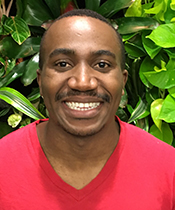Graduate Student Honored by Astronomical and Physical Societies
Christian Aganze wins best student poster by Black Physicists Society
March 25, 2021 | By Zhuoying Lin

Christian Aganze
UC San Diego graduate student Christian Aganze has won the 2020 Beth Brown Memorial Award for his discovery of new and distant brown dwarfs in the Milky Way galaxy.
Aganze was awarded at the National Society of Black Physicists (NSBP) conference in November 2020 for his presentation on “Searching for Distant Ultracool Dwarfs in Deep HST/WFC3 Surveys.” He was honored with the Best Graduate Student Poster Presentation.
The Beth Brown Memorial Award was established by the American Astronomical Society and honors the first African-American woman who earned a PhD in physics, Dr. Beth Brown, from the University of Michigan’s astronomy department in 1998.
As an astrophysicist at NASA, Brown studied elliptical galaxies, and was passionate to share astronomy with the public through websites and television interviews. Brown also took on leadership roles in NSBP to help minorities and women to succeed in physics. She died unexpectedly at the age of 39 due to pulmonary embolism.
Aganze is a fifth-year PhD student in physics. In Professor Adam Burgasser’s Cool Star Lab, Aganze studies brown dwarfs, a type of celestial object with masses between stars like the Sun and giant planets like Jupiter. The goal of his research is to estimate the age of brown dwarfs by analyzing their “scale height” in the Milky Way. Scale height measures how objects are distributed perpendicular to the plane of the Milky Way. As brown dwarfs get older, they tend to move away from the plane, so scale-height measurements provide a way of estimating the age of the entire population. Aganze’s study provides important insights into the formation history and chemical evolution of the universe.
Current knowledge of brown dwarfs and their distributions in the Milky Way are largely limited by the sensitivity of infrared and optical telescopes. The faint luminosities of brown dwarfs make those located at distances further than 1 kiloparsec, or 3,000 light years, difficult to detect from ground-based telescopes.
To expand the identified sample of brown dwarfs, Christian used the data gathered from the NASA Hubble Space Telescope (HST). This telescope, located above the obscuring effects of our atmosphere, has enough sensitivity to detect brown dwarfs at the near-infrared wavelengths in which they shine brightest.
Through the 3D-HST parallel survey, Aganze discovered 182 M7-T9 dwarfs, with the letters and numbers indicating the object’s spectral type, which is related to their temperature.
“Christian has put in a lot of hard work and creative insight into this research, and I think that came through when he presented at the conference,” said Burgasser. “He had to develop new machine learning methods to find a few brown dwarfs among hundreds of thousands of sources, then create a sophisticated model to turn those discoveries into a measurement of our galaxy.”
“I felt encouraged in my research,” said Aganze. “I do notice the statistics of the Black physicists is small, and the award helps boost the number.”
At the Cool Star Lab, Burgasser is active in his support of equity, diversity and inclusion.
“I think recognizing that everyone’s contributions are valuable creates a group that is more welcoming for all members, including those from underrepresented groups,” said Burgasser. “I also try to create a culture of mutual support—we help each other—to both reduce the stigma of seeking help as well as empowering each of us to be experts in our own way. I was fortunate to learn these ideas from my own advisors and collaborators.”
The Division of Physical Sciences at UC San Diego launched the Student Success Center in February 2020 to support minority students in their professional careers in the science, technology, engineering and mathematics fields. The center and several collaborators around UC San Diego also reactivated the campus chapter of Society for Advancement of Chicanos/Hispanics and Native Americans in Science to facilitate the success of underrepresented communities in STEM.
